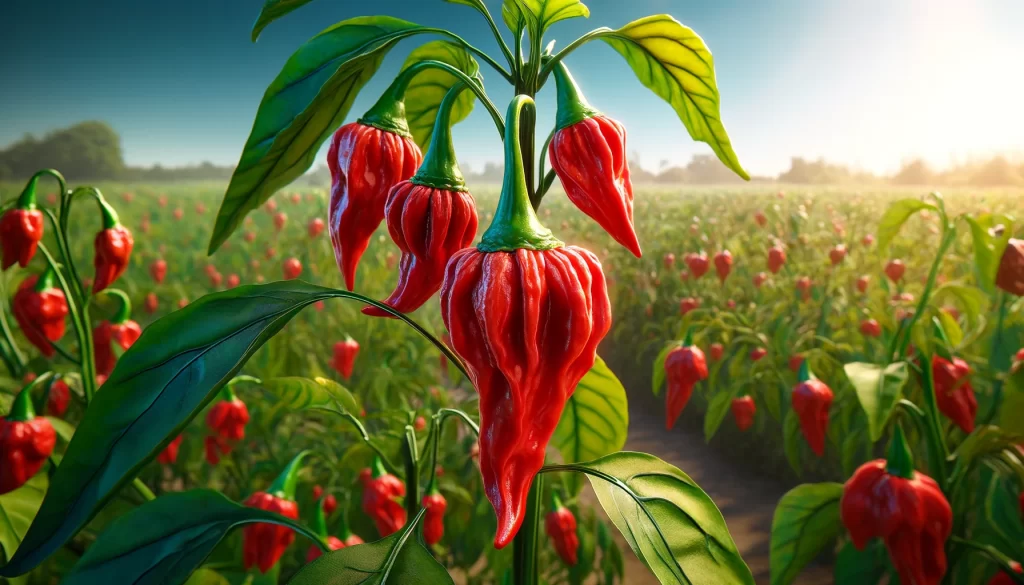Chilies are spicy due to the presence of chemical compounds called capsaicinoids, with capsaicin being the most prevalent and potent. These compounds are mainly found in the placenta of the chili, the white inner part where the seeds are attached. Capsaicin binds to TRPV1 receptors in the mouth and other areas of the human body, which normally respond to heat and abrasion, causing the sensation of burning and spiciness.

Capsaicin and Other Capsaicinoids
Capsaicin is the main capsaicinoid responsible for spiciness. Other capsaicinoids, such as dihydrocapsaicin, also contribute to the effect, though to a lesser extent. These compounds are alkaloids that evolved in chili plants as a defense against mammals and other herbivores.
TRPV1 Receptors
When capsaicin comes into contact with TRPV1 receptors (transient receptor potential vanilloid type 1) in the tongue and mouth, these receptors send signals to the brain interpreted as pain and heat. TRPV1 receptors are responsible for detecting and regulating body temperature, and also respond to acids and irritating chemicals.
Defense Mechanism
Evolutionarily, capsaicin serves as a defense mechanism for the chili plant, deterring mammals from consuming the fruits. However, birds are not affected by capsaicin, allowing them to disperse chili seeds through their droppings, helping the plant spread.
Sensation of Relief
Although capsaicin causes a burning sensation, it also stimulates the release of endorphins in the brain, which can generate a feeling of well-being and pleasure. This explains why some people enjoy spiciness despite the initial pain.
Scoville Scale
The spiciness level of chilies is measured in Scoville Heat Units (SHU), indicating the amount of capsaicin present. Milder chilies, such as bell peppers, have 0 SHU, while the spiciest chilies, like the Carolina Reaper, can exceed 2 million SHU.

Effects on the Body
In addition to the spiciness in the mouth, capsaicin can cause various effects on the body, such as sweating, increased salivation, tearing, and, in extreme cases, gastrointestinal discomfort. These effects are generally temporary and disappear once the capsaicin is metabolized.
| # | Name | Description | Region | Capsaicinoids (SHU) |
|---|---|---|---|---|
| 1 | Carolina Reaper | Currently the world’s hottest chili. | South Carolina, USA | 2,200,000 |
| 2 | Trinidad Scorpion Butch T | Very high heat, native to Trinidad. | Trinidad and Tobago | 1,463,700 |
| 3 | 7 Pot Douglah | Dark brown, very high heat. | Trinidad and Tobago | 1,853,936 |
| 4 | 7 Pot Barrackpore | Exceptionally hot, native to Trinidad. | Trinidad and Tobago | 1,500,000 |
| 5 | Ghost Pepper | Also known as Bhut Jolokia, native to India. | India | 1,041,427 |
| 6 | Komodo Dragon | High heat, hybrid pepper. | United Kingdom | 1,400,000 |
| 7 | Naga Viper | Hybrid pepper with very high heat. | United Kingdom | 1,382,118 |
| 8 | Infinity Chili | Extremely hot chili developed in the UK. | United Kingdom | 1,176,182 |
| 9 | Dorset Naga | Extremely hot, cultivated in Bangladesh. | Bangladesh | 1,598,227 |
| 10 | 7 Pot Brown | Dark brown, high heat. | Trinidad and Tobago | 1,853,936 |
| 11 | 7 Pot Primo | Exceptionally hot, crossbreed pepper. | USA | 1,473,480 |
| 12 | Trinidad Moruga Scorpion | Extremely hot, native to Trinidad. | Trinidad and Tobago | 2,009,231 |
| 13 | Pot Douglah | Very high heat, Trinidad variety. | Trinidad and Tobago | 1,853,936 |
| 14 | Pot Primo | Extremely hot, crossbreed pepper. | USA | 1,473,480 |
 AgronoBlog – Agriculture Blog
AgronoBlog – Agriculture Blog 


